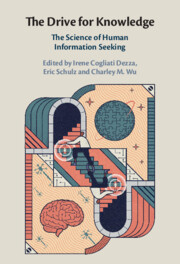Book contents
- The Drive for Knowledge
- The Drive for Knowledge
- Copyright page
- Contents
- Figures
- Tables
- Notes on Contributors
- Preface
- Part I What Drives Humans to Seek Information?
- Part II How Do Humans Search for Information?
- Part III Which Machinery Supports the Drive for Knowledge?
- Chapter 9 Information-Seeking in the Brain
- Chapter 10 Attention as Rational Choice
- Chapter 11 Seeking Inner Knowledge
- Chapter 12 Edgework
- Future Challenges
- Index
- References
Chapter 10 - Attention as Rational Choice
from Part III - Which Machinery Supports the Drive for Knowledge?
Published online by Cambridge University Press: 19 May 2022
- The Drive for Knowledge
- The Drive for Knowledge
- Copyright page
- Contents
- Figures
- Tables
- Notes on Contributors
- Preface
- Part I What Drives Humans to Seek Information?
- Part II How Do Humans Search for Information?
- Part III Which Machinery Supports the Drive for Knowledge?
- Chapter 9 Information-Seeking in the Brain
- Chapter 10 Attention as Rational Choice
- Chapter 11 Seeking Inner Knowledge
- Chapter 12 Edgework
- Future Challenges
- Index
- References
Summary
I argue for a new operationalization of attention as a process of information selection that is endogenous, rather than exogenous, to decision-makers’ goals and constraints. Traditional accounts postulate that attention is captured in a “bottom-up” fashion by external sensory stimuli or in a “top-down” fashion by external experimental instructions. In contrast, recent studies of information-demand provide a powerful alternative view whereby attention is allocated endogenously to serve a decision-maker’s goals, and is subject to the decision-maker’s knowledge, biases, and constraints. I review neurophysiological evidence supporting this view, with a focus on optimal and potentially suboptimal forms of attention allocation aimed to reduce uncertainty and enhance reward gains.
- Type
- Chapter
- Information
- The Drive for KnowledgeThe Science of Human Information Seeking, pp. 217 - 236Publisher: Cambridge University PressPrint publication year: 2022

